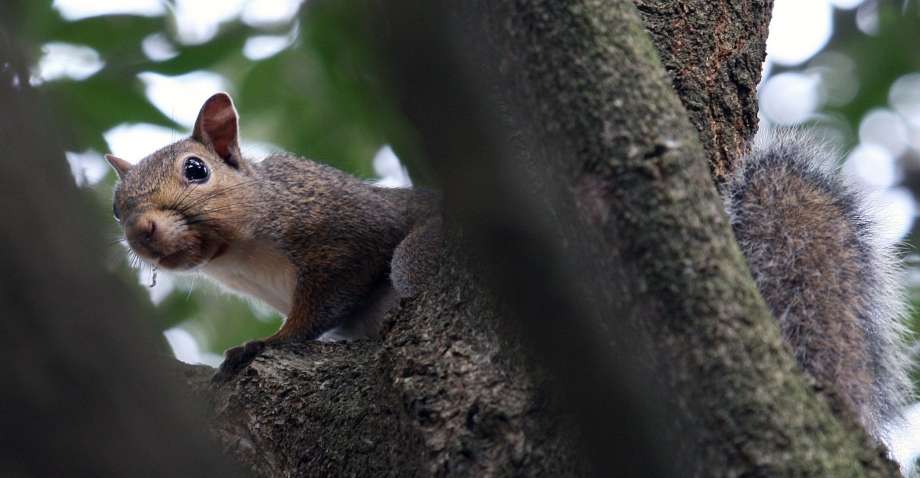
Need help today? Don't wait
> FIND A LOCATIONSquirrels
THE RISKS SQUIRRELS BRING TO YOUR HOME
Black, grey and red squirrels are busy rodents. They are a fixture in many communities, capable of producing two litters of babies per year — one in spring and another in late summer. Squirrels can chew holes into homes and scamper within the walls and attic spaces, where they build nests, cause structural damage and pose numerous health risks.
WHAT WE DO FOR YOU
The best way to humanely remove and exclude squirrels from your home is with a customized removal and exclusion plan. Skedaddle technicians understand that each home has its own vulnerabilities when it comes to squirrel entry. Opportunities for squirrels to gain entry depend on how your home was constructed, the materials used and its current condition. We begin every removal with a thorough assessment of your home to understand how squirrels got in, where they may get inside in the future and the extent of damage they have caused. Our friendly technicians will use this information to create a customized removal plan, walking you through each step of the process from start to finish. Your property assessment helps ensure that each and every squirrel entry point is identified and secured..
Skedaddle relies on over 30 years of experience to determine where squirrel’s have made their den, including the hardest areas to reach inside your home. Our knowledge of home construction and squirrel behaviour allows us to resolve any squirrel problem, no matter how challenging. Hiring professionals that know which tools, techniques and strategies to use reduces property damage and saves homeowners money in the long run. Skedaddle’s hands-on approach to squirrel removal is backed by a lifetime warranty. Our friendly technicians are always available to help if any issues arise in the future, and ensure your wildlife problem has skedaddled for good.
WHY YOU NEED SQUIRREL REMOVAL SERVICES
Squirrel’s have powerful teeth that are constantly growing. They use their strong bite to chew openings into your attic through soffits, fascias and vents. The truth is that many of the materials used to construct our houses, including aluminum, vinyl and wood are no match for a squirrel’s teeth, and with small bodies they only need a two inch gap to squeeze inside. Their job is made easier as our homes age and deteriorate from weather damage.
Once they have made their way inside, squirrels are capable of causing costly damage to attic insulation, electrical and duct work and compromise the structural integrity of your home. Despite their small size, a squirrel’s need to chew, combined with their constant activity, can lead to extensive damage in hard to reach places. Skedaddle technicians are equipped with the professional equipment and techniques to safely reach the highest points of a home and remove hazardous materials. By accessing the squirrel’s den site we can identify chewed electrical wiring, soiled insulation and structural damage.
When baby squirrels are present in the home, removal becomes more complicated. Squirrels have two mating seasons, with the first litter arriving between February and April, and the second in the last weeks of August and into September. During this time, young squirrels are immobile and under the watchful eye of defensive mothers. Skedaddle’s technicians are trained to safely locate squirrel babies, often with the help of thermal imaging cameras, and remove them by hand. The babies are then placed in a baby reunion box that keeps them safe and warm until their mother is removed. Once the family is reunited outside the home, and her path back in has been blocked, the mother must relocate her litter to one of her other den sites in the area.

Squirrels Seek Shelter Indoors During the Winter Months
While you may spot squirrels this winter nesting in tree cavities or leaf piles, many prefer to find shelter in warmer, more secure spots like attics, wall cavities, and sheds. These indoor spaces provide a cozy winter home for squirrels to store their food and escape the harsh elements. Although squirrels do not hibernate, they spend much of the winter indoors to avoid the cold, emerging only on warmer days to gather more food. This behavior can make it harder for homeowners to detect a squirrel problem until significant damage has been done.
Squirrel mating season begins in January, with the first litters arriving as early as late February. Once a female squirrel has found a safe space to nest, she will use it to raise her young in the spring. This can lead to even more destruction, as the arrival of a litter of active baby squirrels makes the situation even more complicated. Many homeowners mistakenly assume that squirrels will leave once the weather warms up. However, squirrels often stay in their winter den well into the spring, and some may even return the following year.
It’s crucial to act quickly at the first signs of squirrel activity to prevent further damage to your home. While the fall and early winter months are ideal for evicting squirrels before they cause major damage, Skedaddle Humane Wildlife Control is available year-round to help ensure your home remains squirrel-free throughout the snowy season.
Our Wildlife Technicians are trained to identify all squirrel entry points into your home. Squirrels are incredibly adaptable, which is why humanely and strategically removing all adults and their babies, followed by professionally sealing your home against further entry, is the most effective and economical approach. Squirrels can fit through or chew open small holes anywhere from the foundation up to your roof, which is why our technicians complete a throughout 35-50 point inspection of your home to identify every potential entry point.Our technicians use their knowledge and experience to determine where the squirrels are nesting and get themselves into the nooks and crannies of your attic to perform a hands-on removal of any babies. We then use the babies to lure out the mother so they can all be reunited outside of your home. Once the mother has been locked out she will relocate her babies to one of her other den sites in the neighbourhood.
Why do Squirrels Live in Attics?
How Do Squirrels Get into Houses?
How to Get Rid of Squirrels?
Are Squirrels Nocturnal?
How To Keep Squirrels Out Of My Attic?
What Are The Signs Of Baby Squirrels In My Attic?
Skedaddle Humane Wildlife Control’s wildlife removal strategy is humane, safe and reliable. Part of our process involves clearing and cleaning any contamination that can pose serious health concerns. Inside homes, squirrels can chew wiring and build messy nests of dry leaves and twigs that can measure several feet in size. It’s important to have the contamination removed professionally because squirrels and their nests carry ticks and fleas, which can bother pets and humans alike.
Since squirrels are able to access many hard to reach places such as; ventilation systems and wall cavities, it can be impossible to remove all traces of bacteria and dry materials without professional help. Your Wildlife Technician will advise cleaning and clearing squirrel nesting material and soiled insulation from urine and feces, depending on the severity of contamination. This will help ensure your home is a safe and healthy place for you and your family.
How to Repair Squirrel Damage?
Why Do Squirrels Chew Wires?
What Are The Risks Of Squirrels In My Attic?
It’s impossible to get rid of all the squirrels in your neighbourhood, that’s why Skedaddle’s process includes making sure that your home is protected against future squirrel intrusions. Our wildlife technicians use heavy gauge screening to close off any openings at risk for further squirrel entry. We use high-quality products and materials and professionally install them so they stand the test of time.
Once each entry point is secured they will then be deodorized to mask any hormonal scents that may attract other unwanted guests. With over three decades of experience identifying and repairing wildlife damage, we have what it takes to keep the squirrels out. Skedaddle Humane Wildlife Control specializes in ensuring that your home and family are protected as part of our customer service experience.
How Can I Keep Squirrels Out Of My House?
Why Do it Yourself Measures Don’t Work for Squirrel Removal?
How to Keep Squirrels Out During Winter?
COMMON SQUIRREL QUESTIONS
HOW DO SQUIRRELS GET INTO ATTICS?
Squirrels are excellent climbers that can access roofs with the help of tree limbs, powerlines or by scaling up the exterior. Once on the roof, squirrels use their teeth to chew through aluminum, plastic or wood to get inside. Fascias, vents and soffits are no match for determined squirrels, who only need to create or find a small sized hole to squeeze in.
DO SQUIRRELS HIBERNATE?
Squirrels do not hibernate, instead they create a den site where they can find shelter for the winter, often leading them to our attics. The storage of food they have collected and their reduced activity, help squirrels survive the winter. Decreased squirrel activity during the cold months can also make identifying a squirrel infestation more difficult.
WHEN DO SQUIRRELS HAVE BABIES?
Squirrels have two mating seasons. The first litter of babies arrives between February and April, with the second following in the late weeks of August and into September. Litters can consist of anywhere from one to nine babies. Until they have reached eight weeks of age, young baby squirrels are unable to walk and leave the den site on their own. During this time they must be gently removed from the den site by hand.
WHAT KIND OF DAMAGE CAN SQUIRRELS CAUSE?
Squirrels can cause extensive and costly amounts of damage in a short period of time. Since they have constantly growing teeth, squirrels will chew support beams, electrical wiring, drywall and exterior materials to file them down to size and keep them sharp. During their stay, squirrels leave hazardous droppings, urine and dry nesting materials throughout insulation, wall cavities and ventilation systems.
ARE SQUIRRELS NOCTURNAL?
Squirrels are not nocturnal. Like us, they are most active during the day, and use the night to rest in their den. While you may hear the odd noise at night, you are most likely to hear the sound of a squirrel infestation at sunrise as they start their day and again at sun down when they return to their den.
CALL US TODAY
1.888.592.0387
OR
Request for Services







